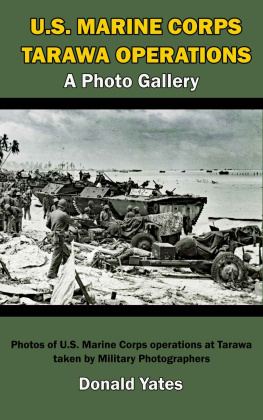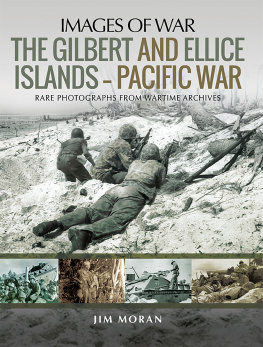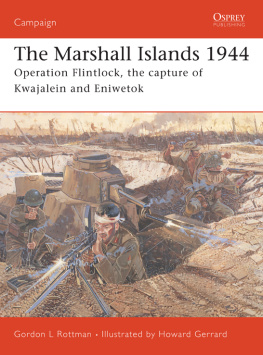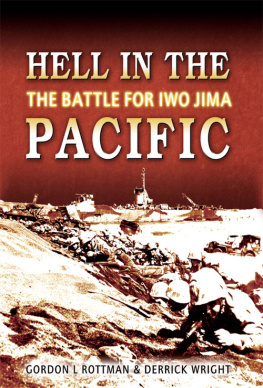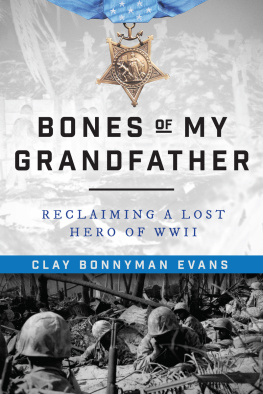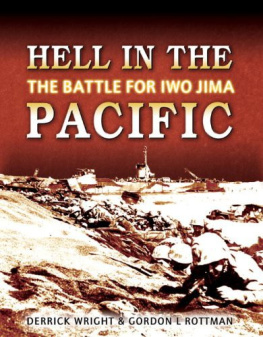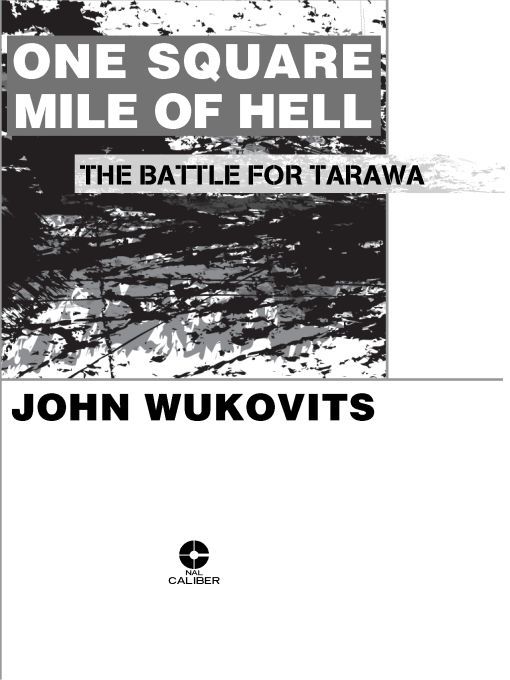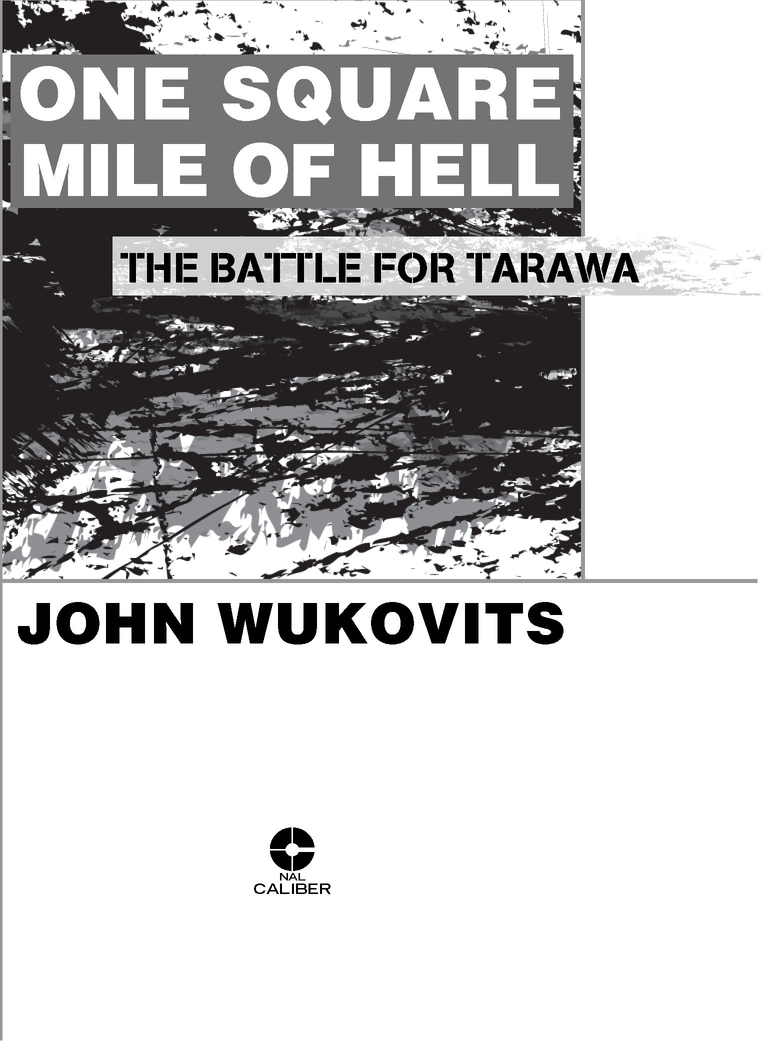Table of Contents
Praise forOne Square Mile of Hell
The best book I have ever read about the battle for Tarawa.... His vivid account of this horrific amphibious campaign is must reading for all Marines and World War II history buffs.Gunnery Sgt. Jack Coughlin, USMC (ret.), author of Shooter:
The Autobiography of the Top-Ranked Marine Sniper
In this remarkable book, we smell the sulfurous stink of artillery, hear the impact of bullets into flesh, and taste the bitterness of blood.... We owe a debt to Wukovits for reminding us of the American heroes who gave every ounce of their strength and courage to kick open the gate to Tokyo.
Homer Hickam, author of Rocket Boys
A well-researched and detailed account of the battle for Tarawa [that] reflects the horrible battle and determined glory of the U.S. Marines.
Congressman Ike Skelton (D-MO), ranking member on the House Armed Services Committee
Wukovits takes you right up the beach with those brave, unlucky Marines who landed at Tarawa ... a harrowing, riveting story, carefully researched and very well told.Evan Thomas, assistant managing editor, Newsweek
Narrative history at its best... [a] masterful blend of personal interviews and combat action provides a human face for the thousands of U.S. Marines and Navy corpsmen who fought that landmark battleand their families at home who waited in dread for the butchers bill to be announced.
Col. Joseph H. Alexander, USMC (ret.), author of Utmost Savagery: The Three Days of Tarawa
Wukovits has done it again. Following on the heels of his gripping Pacific Alamo, his work solidifies his position as one of the preeminent chroniclers of the Pacific War. No one is better at thrusting the reader into the heat and stench of battle. Indeed, his prose paints such a vivid portrait of combat that one can almost feel the troops tension, fear, exhilaration, and exhaustion.
Flint Whitlock, author of The Fighting First: The Untold Story of the Big Red One on D-Day
Thorough, accurate, and highly readable... captures the brutality, horror, and poignancy of warfare.Michael E. Haskew, editor, WWII History Magazine
As fine a history of men at war as I have ever read, seen through the eyes of the gallant men who won one of the most ferocious battles in our history. A story of high courage every American should read.
Col. Robert Barr Smith, U.S. Army (ret.)
To my brother, Tom,whose encouragement andpraise make me smilewith the realization thatmy big brother is proud
PREFACE
I have long been familiar with the story of Tarawa. One of the first pieces I wrote, a magazine article more than twenty years ago, dealt with the subject, and the battle has remained with me ever since. The frightening walk toward shore, so reminiscent of what Steven Spielberg later handed theater audiences in the opening moments of Saving Private Ryan, captivated me, and the appalling slaughter that unfolded over the three days of fighting made me appreciate what those young Marines endured to wrest a piece of sand from the enemy.
In the early 1990s I had the pleasure of interviewing one of the main participants, Time magazine correspondent Robert Sherrod. His brilliant reportage of the battle printed in the pages of the newsweekly, followed by his moving 1944 book, Tarawa, first conveyed the Pacific Wars terrible reality to the American people. Over three interviews, he regaled me with tales of his wartime experiences, in which Tarawa played such a prominent part. His insight and comments helped me better understand what unfolded that November in 1943.
Research took me to Quantico, Virginia, and Washington, D.C., where I scoured the official Marine records and the personal papers of participants. I traveled to Laguna Beach, California; Alexandria, Virginia; and San Antonio, Texas, to interview survivors and family members. At each location I gathered material that clarified different features of the fighting and met individuals whose courage of more than sixty years ago was matched by the quiet emotions they retain today. This story exists because of them.
Rather than simply fashion a minute-by-minute account of the fighting that raged at Tarawa, I chose to tell the story through the experiences of a handful of participants. Collectively, these individuals typify what the Marine at Tarawa faced as well as what families and loved ones back home endured. By implication, they also represent the experiences and sacrifices made by the military throughout the Pacific and by their families and friends in the United States.
I included a variety of ranks as well as men with differing responsibilities so that I could better convey the drama of Tarawa, including two corporals who had been boyhood friends, three brothers, a colonel, a corpsman, a combat photographer, and a Medal of Honor winner. These men and their families allowed me to present each aspect of the fightingthe Marine riflemen who carried the brunt of the fighting, the correspondents who covered the fighting, the corpsmen who patched the wounded, the families who anxiously awaited word of their loved onesand to do so in a more personal fashion than can be done strictly by focusing on official reports.
I would like to thank many people. My agent, Jim Hornfischer, who knows what it takes to write a book, nurtured the project from start to finish. The valuable comments made by my editor at New American Library, Mark Chait, improved the manuscript, while Jeffrey Ward again added his marvelous artistic touch to the maps that adorn the book. Barry Zirby at the National Archives; Fred Allison, Charles Melson, and Gordon H. Heim at the Marine Corps Historical Center; Gale Munro at the Navy Art Collection; and Dr. James Ginther and the staff at the marvelous Marine Corps Research Center in Quantico, Virginia, lent valuable assistance whenever needed. Col. C. W. Van Horne, USMC (Ret.), the executive secretary of the Second Marine Division Association, sent me a list of Tarawa veterans and put me in touch with men who contributed fascinating material to the book. Agent Irene Webbs continued belief in my stories makes me work more assiduously to bring the contributions of World War II veterans to current generations.
This book would not be whatever it is without the assistance of the many men and women I interviewed. Veterans imparted their reminiscences, families opened homes, and loved ones shared letters from long ago. A complete list of the people I talked with is found in the bibliography, but I must thank a few for the enormous contributions they made. The Montague family in Bandera, Texas, and the Seng family in San Antonio spent hours with me around the kitchen table or on the telephone, confiding stories and handing over photographs or priceless letters written in 1942 and 1943. Stanley Bowen and his wife, Marge, welcomed me to Laguna Beach, where they provided a fascinating account of their time in World War II. I never truly grasped how a Marine operated in battle until Robert Muhlbach explained his method of attacking Japanese pillboxes at Tarawa. James Wendell Crain clarified the hectic conditions at Red Beach 1, and James and Dick Meadows added powerful material about their time in the battle. Norman Hatch and William Kelliher proved that battlefield heroes often accomplish their tasks without weapons, while Robert Sherrod movingly explained the wade ashore and the aftermath during his extensive interviews.



